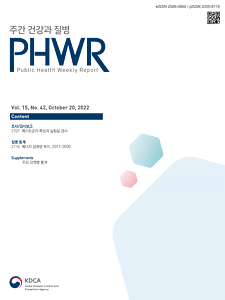Current Issue
Vol.15 No.42, October 20, 2022
-
Surveillance Reports 2022-10-20
 0
0
 156
156
 37
37
Yersinia pestis: Characteristics and Laboratory Diagnosis
Seong Wook Pyo, So-Hyeon Kim, Hwajung Yi, Gi-eun Rhie*
Public Health Weekly Report 2022; 15(42): 2707-2715 https://doi.org/10.56786/PHWR.2022.15.42.2707 Abstract
AbstractYersinia pestis is a facultative anaerobic, Gram-negative coco-bacillus and causative agent of the zoonotic disease plague. Y. pestis is a high-risk pathogen that can be transmitted to humans by the bite of infected fleas or rodents, direct contact with infectious body fluids or tissues, and inhalation of respiratory droplets from a person with pneumonic plague. According to clinical symptoms, plague is divided into bubonic plague, septicaemic plague and pneumonic plague. Especially, pneumonic plague can be a very dangerous disease with a case-fatality ratio of close to 100%. For the laboratory diagnosis of Y. pestis , various diagnostic methods through the culture and isolation of pathogen are being used. Currently, the plague is sporadically occurring in Democratic Republic of the Congo, Madagascar and Peru. There have been no cases in Republic of Korea, but prompt response and diagnosis are required in case of suspected cases caused by foreign imports or bioterrorism. For this purpose, it is important to understand the plague with continuous education and to prepare for laboratory tests.
-
QuickStats 2022-10-20
 0
0
 1973
1973
 646
646
Trends in Energy Intake, 2011–2020
Public Health Weekly Report 2022; 15(42): 2716-2717 https://doi.org/10.56786/PHWR.2022.15.42.2716

pp. 1433~1461
Most Keyword
?
What is Most Keyword?
- It is the most frequently used keyword in articles in this journal for the past two years.
Most Read
-
Waterborne and Foodborne Disease Outbreaks in the Republic of Korea, 2023
Myung-Jae Hwang, So Yeon Park, Hyungjun Kim, Se Jeong Yang, Sungchan Yang, Jin Seon Yang
Public Health Weekly Report 2025;18: 17-32 https://doi.org/10.56786/PHWR.2025.18.1.2 -
Implementation Plan for the Coronavirus Disease 2019 Vaccination for the 2024–2025 Season: Recommendations of the 6th Expert Committee on Immunization Practices
Hyewook Hwang, Wookeon Lee, Seohyeon Ahn, Young-Sook Choi, Seunghyun Lewis Kwon, Dongwoo Lee, Eun Hwa Choi, SokGoo Lee
Public Health Weekly Report 2025;18: 90-102 https://doi.org/10.56786/PHWR.2025.18.2.3
Editorial Office
+82-43-719-7569





 Full Text
Full Text Cite
Cite


